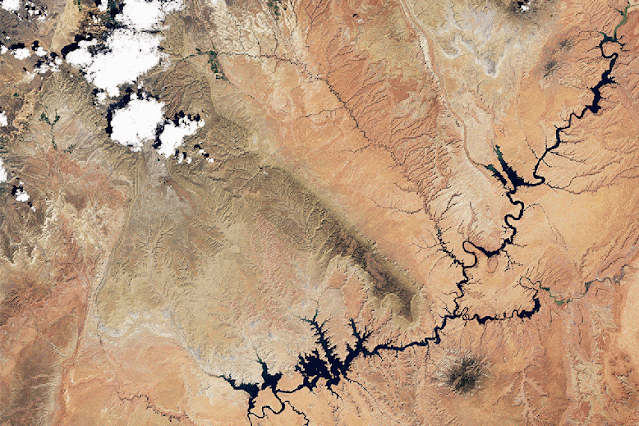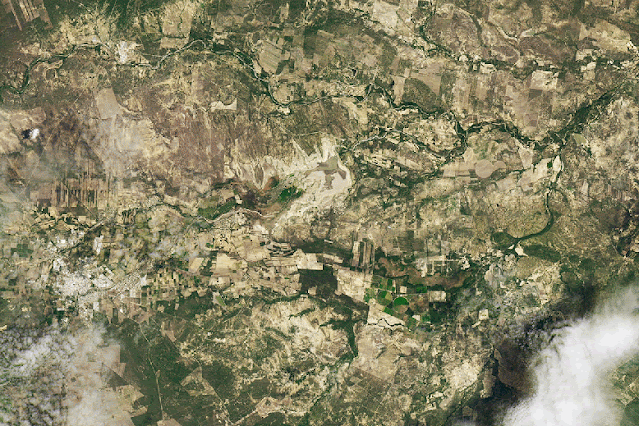The megadrought in southwest North America is the worst in over a thousand years. These satellite images show how much the severe drought is altering the landscape.
 |
| South-western North America is experiencing a megadrought NASA Earth Observatory |
The images shown here were mostly taken by satellites that were launched specifically to collect data on how the Earth's surface changes over time. Many are from NASA's and the US Geological Survey's Landsat program, which has provided nearly 50 years of continuous imaging of the planet's surface and helped researchers put this massive drought into context.
The Colorado River
 |
| NASA/GSFC/MITI/ERSDAC/JAROS, as well as the US/Japan ASTER Science Team |
The image above depicts the Colorado River, which once ran from northern Colorado to the Gulf of California. The river would have formed a blue line through this entire image about 80 years ago, flowing from the top left to the mouth of the gulf at the bottom right. The river now comes to an end just south of the green farmlands at the top of the image.
The bluish-purple line that appears to continue all the way to the gulf is actually an inlet formed by water lapping inland from the gulf. The entire river basin covers approximately 8% of the continental United States and serves approximately 40 million people. Its slow drying is concerning for both the American West and northern Mexico.
Colorado reconnected to the ocean
 |
| From April 2013 to April 2014. For a few weeks, the Colorado River reconnected with the ocean. Earth Observatory at NASA |
Very little of the water left in the Colorado River makes its way to Mexico. However, for about two months in 2014, the city of San Luis Ro Colorado in Mexico experienced more than a trickle flowing through the riverbed.
Water and land management agencies in Mexico and the United States agreed to release 130 million cubic meters of water from the Morelos Dam on the US-Mexico border. This resurrected the river long enough for plants and animals to begin returning to areas they had abandoned when the river dried up. The river even connected to the ocean for a few weeks before drying up and retreating once more.
Lake Mead
 |
| From July 2000 to July 2022. Lake Mead in the United States has reached its lowest level since it was first filled. Earth Observatory at NASA |
The lakes fed by the Colorado River are not faring much better. Lake Mead, the largest reservoir in the United States, is currently at its lowest water level since it was filled in 1937. It had reached only 27% of its capacity as of July 2022. It hasn't been close to 100 percent since 1999.
The lake itself supplies water to a large portion of the southern United States and northern Mexico, and its water also powers the famous Hoover Dam - if water levels fall significantly further, the hydropower turbines there may cease to function.
Lake Powell
 |
| From August 2017 to August 2022. Lake Powell in the United States has also reached its lowest level since it was first filled. Earth Observatory at NASA |
Lake Powell, the second largest reservoir in the United States, is also fed by the Colorado River and has reached its lowest water level since it was first filled. It is expected to fall even further by the end of 2022. There are plans to send more water upstream into Lake Powell and less downstream into Lake Mead until April 2023, but it remains to be seen whether these plans will protect the water and power supply provided by these two critical reservoirs.
Cerro Prieto reservoir
 |
| From July 2015 to July 2022. Cerro Prieto reservoir in northern Mexico is nearly empty. Earth Observatory at NASA |
It may sound like a broken record, but smaller reservoirs, such as the Cerro Prieto reservoir near Guadalupe in northern Mexico, are in even worse shape. This reservoir had only 0.5% of its maximum water capacity as of July 2022, meaning that no water could be extracted. Government agencies were forced to divert water away from industrial and agricultural uses in order to ensure that people living in the surrounding areas had enough to eat.
Mount Baker
 |
| From July 2013 to July 2015. Mount Baker's snow cover is dwindling. Earth Observatory at NASA |
In a drought, not only does water disappear; but snow also disappears. Much of the water in these lakes and rivers is melted snow from the mountains. Mount Baker in Washington is the highest peak in the North Cascades and has a year-round patch of snow and ice on its summit. That patch is getting smaller. The same thing is happening in the mountains of the American West. Less snow is falling, glaciers are receding, and less water is flowing downhill into the rivers and streams that keep people and wildlife hydrated all year. Everything is interconnected, and everything is drying up.
The Great Salt Lake
 |
| From June 1985 to July 2022. The megadrought has also had an impact on Utah's Great Salt Lake. Earth Observatory at NASA |
Even the Great Salt Lake in Utah, the largest saline lake in the United States, has been affected by the unprecedented drought. After massive and long-lasting drops in water levels, nearly half of the lakebed is now exposed. Because the Great Salt Lake is a closed basin (it sits at the confluence of three rivers and no water flows out of it), some of the declines in water level can be attributed to the water that once flowed into it being extracted and used; however, the less snowmelt flows in through the rivers, the less water there is to extract or fill the lake.
The lake is vital to the local economy, from tourism to mining and beyond. It is also an important ecosystem for migrating birds, and when exposed, the dust in the lakebed can cause massive dust storms, so losing the Great Salt Lake could spell disaster for the surrounding area. There are potential plans to save it, but many are costly and all require significant legislative support, so it is unclear whether they will be implemented.
